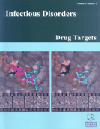- Home
- A-Z Publications
- Infectious Disorders - Drug Targets (Formerly Current Drug Targets - Infectious Disorders)
- Previous Issues
- Volume 11, Issue 4, 2011
Infectious Disorders - Drug Targets (Formerly Current Drug Targets - Infectious Disorders) - Volume 11, Issue 4, 2011
Volume 11, Issue 4, 2011
-
-
Usefulness of Real-Time PCR for the Diagnosis of Sepsis in ICU-Acquired Infections
More LessAuthors: Frederic Wallet, Caroline Loiez, Stephanie Herwegh and Rene J. CourcolReal-time PCR methods are able to rapidly detect a wide panel of microorganisms. These methods are of interest in critically ill patients to determine the presence of bacteria in the blood and other biological samples, especially in those patients with prior antimicrobial treatment. In intensive care unit (ICU), the LightCycler SeptiFast (LC-SF) Test provides 1.5 to 2 fold higher positivity rate compared with conventional bl Read More
-
-
-
Cytomegalovirus Infections in Non-Immunocompromised and Immunocompromised Patients in the Intensive Care Unit
More LessAuthors: Diana F. Florescu and Andre C. KalilInfection, inflammatory response, activation of coagulation cascade and sepsis are tightly interconnected. In the initial phase, sepsis is characterized by a pro-inflammatory state, while in the late phase, by an anti-inflammatory state which favors cytomegalovirus reactivation. Cytomegalovirus infection would accentuate the sepsis-induced immunologic effects increasing the risk for other infections. The rate of Read More
-
-
-
New Methods to Clean ICU Rooms
More LessAuthors: Caroline Blazejewski, Mary-Jane GUERRY, Sebastien Preau, Alain Durocher and Saad NseirHospital-acquired infections (HAI) represent the most common adverse event in the intensive care unit (ICU). Their prevalence is high and they are associated with increased morbidity and mortality. The environment plays a central role in the transmission of hospital-acquired pathogens (HAP) and in the pathogenesis of HAI. Many bacteria, especially multidrug resistant ones, can survive for several months in the hospital enviro Read More
-
-
-
How Could We Reduce Antibiotic Use in Critically Ill Patients?
More LessAuthors: Giulia De Angelis, Giovanni Restuccia, Roberto Cauda and Evelina TacconelliThe role of antibiotic pressure in the selection of antibiotic-resistant bacteria is still under debate in the scientific community and often confounded by scarce data on antibiotic usage. Several studies demonstrated that prior antibiotic exposure is likely to increase patient's colonization and infection by antimicrobial-resistant bacteria. Of even more concern is the significant mortality associated with these infections, in partic Read More
-
-
-
Non-Invasive Mechanical Ventilation to Prevent ICU-Acquired Infection
More LessAuthors: Thomas Baudry and Florence AderSeveral forms of supportive techniques for respiration in intensive care units (ICU) are currently available. The most widely used is invasive mechanical ventilation through the use of an endotracheal tube (ETT). ETTs are proved to be important contributors to the pathogenesis and development of ventilator-acquired pneumonia (VAP) as artificial airways interfere with a number of respiratory tract defence mechanis Read More
-
-
-
Novel Therapies for Pseudomonas aeruginosa Pneumonia
More LessAuthors: Damien Roux and Jean-Damien RicardP. aeruginosa is the bacteria most commonly responsible for hospital-acquired and ventilator-associated pneumonia. Numerous factors are encoded in its genome, and they explain its high virulence. P. aeruginosa also develops a quorum sensing (QS), which coordinates the expression of these factors. The type III secretion system, a needle-complex, allows exotoxin injections into eukaryotic cells and is involved in the path Read More
-
-
-
Adjunctive Therapies in Severe Pneumonia in Critical Care Patients
More LessAuthors: N. Tzovaras, M. Karvouniaris, D. Makris and E. ZakynthinosAim: To review available evidence for the role of adjunctive therapies in severe pneumonia. Methods: We focused on therapies that have attracted recently interest such as glucocorticosteroids (GCs), statins and recombinant activated protein-C. Results: Experimental animal and human studies showed that GCs are able to modulate the inflammatory response and may offer a benefit in patients with severe sepsis. Randomized tri Read More
-
-
-
New Antibiotics for Severe ICU-Aquired Bacterial Infections
More LessAuthors: Julien Poissy and Eric SennevilleInfection is a major cause of morbidity and mortality in intensive care units (ICU). The impact on prognostic of an inadequate antibiotic therapy is well established. The problem is due to the growing spread of resistant microorganisms, including both Gram-negative and Gram-positive pathogens, especially in the case of ICU-acquired infections. In this context, antibiotics with broad spectrum activity are usually required. Read More
-
-
-
Microaspiration in Intubated Critically Ill Patients: Diagnosis and Prevention
More LessAuthors: Saad Nseir, Farid Zerimech, Emmanuelle Jaillette, Florent Artru and Malika BalduyckMicroaspiration of contaminated oropharyngeal secretions and gastric contents frequently occurs in intubated critically ill patients, and plays a major role in the pathogenesis of ventilator-associated pneumonia. Risk factors for microaspiration include impossible closure of vocal cords, longitudinal folds in high-volume low-pressure polyvinyl chloride cuffs, and underinflation of tracheal cuff. Zero positive end expiratory pr Read More
-
Volumes & issues
-
Volume 25 (2025)
-
Volume 24 (2024)
-
Volume 23 (2023)
-
Volume 22 (2022)
-
Volume 21 (2021)
-
Volume 20 (2020)
-
Volume 19 (2019)
-
Volume 18 (2018)
-
Volume 17 (2017)
-
Volume 16 (2016)
-
Volume 15 (2015)
-
Volume 14 (2014)
-
Volume 13 (2013)
-
Volume 12 (2012)
-
Volume 11 (2011)
-
Volume 10 (2010)
-
Volume 9 (2009)
-
Volume 8 (2008)
-
Volume 7 (2007)
-
Volume 6 (2006)
Most Read This Month
Article
content/journals/iddt
Journal
10
5
false
en


